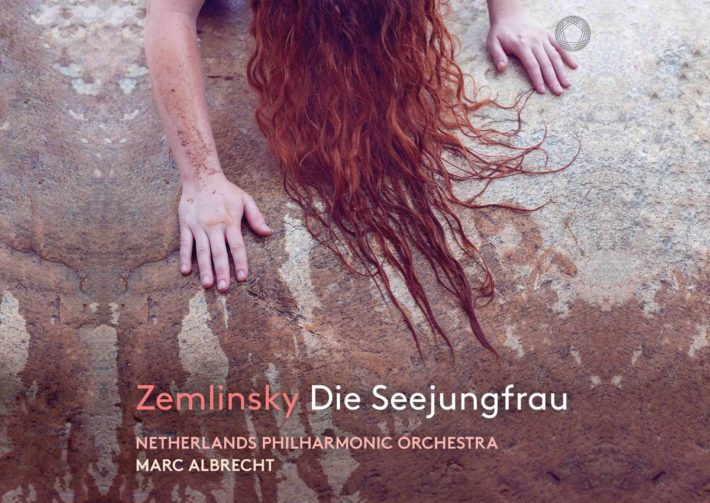Although Alexander von Zemlinsky’s tone poem “Die Seejungfrau” premiered on the same concert in Vienna, 1905, as Schoenberg’s “Pelleas et Melisande,” it received only two further performances, and subsequently wasn’t heard until scholars reconstructed it in the 1980s. The score draws inspiration and a rough narrative from the eponymous story (“The Little Mermaid”) by Hans Christian Andersen. Here, the Netherlands Philharmonic Orchestra performs the piece with their leader Marc Albrecht, recorded live at a 2018 concert.
The NPO excels at creating the different musical moods that Zemlinsky implicitly calls for. The opening, for instance, depicts a murky, underwater scene, slowly coming to life. The basses and harp initially savor each note of the rising melody, but grow more pressing as treble instruments enter. When one of the main motifs is heard in the bass clarinet and muted horn, it is molto legato, almost behind the beat, rather foreboding (the story does have a sad ending, after all). On the other hand, in the second movement, which depicts a celebration, horn calls and cymbal crashes provide ample momentum, and high woodwind flourishes evoke the excitement of a cheering crowd. Later, in a section with similarities to Debussy’s “Jeux de vagues” in La Mer, there is a beguiling duality between playfulness and maturity. The english horn and celli provide a suave melody, while the flutes and glockenspiel provide light commentary – two different characters in a dialogue, perhaps. At the end of the piece, which resembles the “transfiguration” section from Strauss’ Death and Transfiguration, the string section is perhaps not quite as golden and transcendent as one could imagine, but it’s still quite successful. The orchestra’s comfort in all of these different sound worlds makes the otherwise occasionally meandering piece cohere nicely.
Another compelling part of this recording is the solo work from the principal players. Concertmaster Vadim Tsibulevsky uses just the right amount of portamento in his solos to make them feel romantic but not sappy. English hornist Anita Janssen is tasked with exposed melodic lines and small but important chromatic shifts that linger just before the barline, and handles both with a warm tone and sensitive phrasing. In the section depicting the witch (track 2, 7’10”), the oboes use a sharp, piercing tone and succeed in sounding rather nefarious. When the trumpets have their moment at the end of this section, muted, they sound aptly confused. This all adds depth and detail to the colors that the full orchestra is already creating.
Related Classical Music Reviews
- Review: Rimsky-Korsakov – Orchestral Works – Oslo Philharmonic, Vasily Petrenko
- Review: Strauss – Also sprach Zarathustra, Don Juan, Till Eulenspiegel – Urbański
- Review: “Reine de Coeur” Hanna-Elisabeth Müller, Soprano
Finally, Albrecht’s control of the music must be commended. To begin with, the level of detail in tempo markings here is akin to that in Mahler; the piece is filled with pauses, detailed tempo indications like “nicht eilien!” (don’t rush!) or “Ruhig wiegend wie im Reigen” (calmly, weighted like a dance), and too many marks of “espressivo” to count. Yet, the tempo fluctuations feel natural, taken in spirit as much as in practice. In many places, one has the feeling of a heartbeat pervading the orchestra – a steady, but not overly precise pulse. Secondly, Albrecht can pull emotional climaxes out of nothing in just a few bars, and have them disappear just as quickly, for instance 11’00” to 13’00” in the second movement. Again, this lends emotional heft to a piece that can at times be a bit difficult to follow.
The sound quality in this recording is on par with most live recordings – quite good, though not exquisite. The full orchestra’s weight is felt, instead of heard, which is satisfying, and the soloists come through clearly. The balance is wonderful in the quieter sections, but in fortissimos some parts get lost (I occasionally wished for more french horn in the mix). This recording isn’t going to turn Zemlinsky into a household name, but it’s a nice complement to NPO and Albrecht’s previous recordings of Strauss and Mahler. Recommended for any fans of late-Romanticism looking to expand their library.

Zemlinsky – Die Seejungfrau – Fantasy in three movements for large orchestra, after a fairy-tale by Andersen
Netherlands Philharmonic Orchestra
Marc Albrecht – Conductor
Pentatone, CD PTC 5186 740
Recommended Comparisons
Read more classical music reviews or visit The Classic Review Amazon store
Follow Us and Comment:
[wd_hustle id=”HustlePostEmbed” type=”embedded”]











